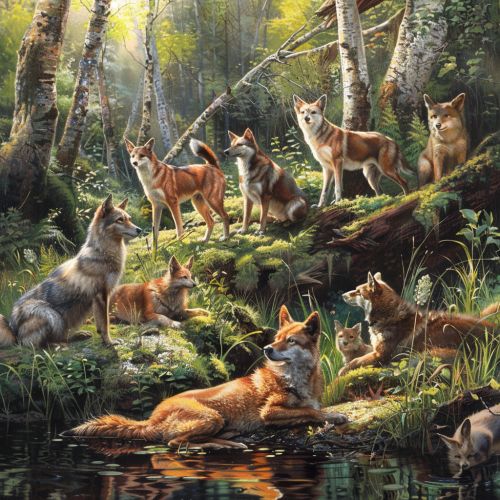Caniformia
Taxonomy and Evolution
Caniformia, also known as Canoidea, is a suborder within the order Carnivora that includes dogs, bears, seals, weasels, and raccoons among others. The Caniformia suborder is one of the two major divisions of Carnivora, the other being the Feliformia suborder which includes cats, hyenas, and mongooses.


The term Caniformia comes from the Latin words 'canis' which means dog and 'forma' which means shape or form. This is due to the dog-like characteristics that are common among the species within this suborder. These characteristics include non-retractile claws and a long snout.
The Caniformia suborder is further divided into two infraorders: Arctoidea and Canoidea. The Arctoidea infraorder includes the families Ursidae (bears), Otariidae (eared seals), and Odobenidae (walruses) among others. The Canoidea infraorder includes the families Canidae (dogs), Mustelidae (weasels), and Procyonidae (raccoons) among others.
The evolution of Caniformia is a topic of ongoing research. The earliest known Caniformia fossil is from the Middle Eocene epoch, approximately 40 million years ago. The Caniformia suborder is believed to have originated in North America and later spread to other parts of the world.
Anatomy and Physiology
Caniformia species exhibit a wide range of sizes, from the tiny least weasel (Mustela nivalis) which can weigh as little as 25 grams, to the polar bear (Ursus maritimus) which can weigh up to 700 kilograms. Despite this wide range in size, all Caniformia species share certain anatomical and physiological characteristics.
One of the key distinguishing features of Caniformia is the presence of non-retractile claws. This is in contrast to the retractile claws found in Feliformia species. Non-retractile claws are better suited for digging and gripping, which are important behaviors for many Caniformia species.
Another distinguishing feature of Caniformia is the long snout or rostrum. The long snout is believed to be an adaptation for a more omnivorous diet, as it allows for a greater variety of food to be consumed. The long snout also houses a large number of scent receptors, making Caniformia species highly reliant on their sense of smell.
Behavior and Ecology
Caniformia species are found in a wide range of habitats, from the Arctic tundra to tropical rainforests. They are also found on all continents except Antarctica. The wide range of habitats is a testament to the adaptability of Caniformia species.
Behaviorally, Caniformia species are highly diverse. Some species, like the gray wolf (Canis lupus), are highly social and live in large packs. Other species, like the brown bear (Ursus arctos), are largely solitary. Caniformia species also exhibit a wide range of diets, from the strictly carnivorous diet of the polar bear to the omnivorous diet of the raccoon.
Conservation
Many Caniformia species are currently facing threats to their survival. These threats include habitat loss, climate change, and hunting. Conservation efforts are underway to protect these species and their habitats. These efforts include habitat protection, captive breeding programs, and legal protections against hunting.
